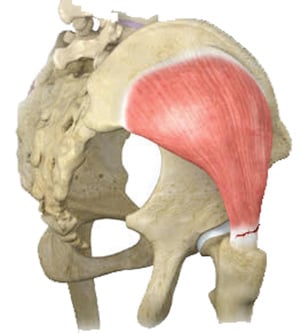
I see a lot of patients with hip pain. Many time, the pain comes on slowly and insidiously out of nowhere, without a fall or specific incident that the patient can blame for its onset. Recently I wrote a piece about femoroacetabular impingement (FAI) and how it can be responsible for hip pain in young adults. Another common cause of hip pain in older individuals that can easily be overlooked is tearing of the abductor tendons.
The hip abductors are a group of muscles on either side of the body that connect the pelvis to the thigh bone and support us when we walk, and position the legs away from the midline of the body. This action is called hip abduction and relies on the healthy function of two main hip abductor muscles, the gluteus medius and gluteus minimus. These muscles function analogously to the rotator cuff muscles in our shoulders and similarly can sustain tears at the tendinous insertion that lead to pain and weakness at the hip.
The typical patient with a tear in her abductor tendon is roughly 50 to 80 years of age and will present with pain on the outer aspect of the hip over the bony prominence of what is called the greater trochanter. This is not actually the true hip joint but is lateral to it. You can feel your own greater trochanter as this bony prominence along the lateral border of the upper thigh at the hip. This location can be painful for a few reasons, only one of which is actually a tear of the abductor tendinous insertion. Most commonly, pain is this area is the result of bursitis, which is often a consequence of tightness of the iliotibial band and weakness of the hip abductors. When that is the case, the pain will reliably respond to conservative treatment consisting of physical therapy and the occasional steroid injection. When lateral hip pain persists despite such treatment, that’s when the treating physician should be alerted to the possibility of abductor tendon injury. Also, significant falls can lead to these muscles tearing more acutely. Patients having tears describe difficulty lying on the affected side at night as well as weakness with getting up out of a seated position or handling stairs. It is this weakness combined with lack of resolution of pain after other conservative treatment protocols are followed that is consistent with there being an abductor tendon tear.
Imaging can be very helpful in diagnosis. MRI is the imaging modality of choice since one can see the tear propagating through the tendon. X-rays are often done first and can heighten the suspicion of a tear of the abductors if abnormalities at the tendon to bone interface can be appreciated. And routine X-ray can rule out other causes of generalized hip pain like arthritis.
Once diagnosed, the treatment approach is not too dissimilar from how we address rotator cuff tears of the shoulder. Unless the tear was noted to come from an acute traumatic event, a conservative treatment regimen utilizing physical therapy will be attempted first. When this fails to help, or in the case of an acute traumatic tear, surgery will be considered.
Like rotator cuff tears of the shoulder, hip abductor tendon tears can be repaired arthroscopically in a minimally invasive fashion. This involves the placement of anchors in the greater trochanter from which stitches are used to capture the avulsed tendon and, via the tying of knots, fixate it back down to the bone. And as long as the tear was not neglected for a prolonged period of time, the results of such surgical repairs are generally very good, allowing folks improved strength and stability with walking and decreased pain at rest.
Recent evidence suggests tears of the abductors of the hip are more prevalent than we previously thought, and the possibility of this injury should be considered when evaluating patients with lateral hip pain that hasn’t improved with time and the application of conservative treatment protocols. In such cases the pain may not be from arthritis but is still the result of a debilitating condition that if recognized early can be treated reliably and successfully.
Dr. Heitman is board certified with the American Board of Orthopaedic Surgery and is a fellow of the American Academy of Orthopaedic Surgeons. He also maintains memberships in the Arthroscopy Association of North America and the American Orthopaedic Society for Sports Medicine attending yearly conferences and surgical labs to stay abreast of the latest operative solutions and techniques. He holds medical licenses in the states of New York, New Jersey and California.










